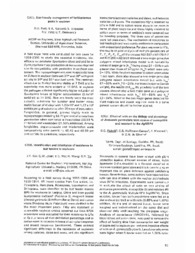Effect of rutin on the biology and physiology of Anticarsia gemmatalis from strains of susceptible and resistant to the AgMNPV.
Effect of rutin on the biology and physiology of Anticarsia gemmatalis from strains of susceptible and resistant to the AgMNPV.
Resumo: Flavonoids in general have been related with plant protection against different sources of stress. Rutin (quercetin 3-O-rutinoside) is a flavonol identified in soybean resistant genotypes and it is known to play an important role on plant defenses against defoliating insects. Nevertheless, some authors have reported that rutin can also interfere with the nuclear polyhedrosis virus (NPV) infections. Experiments were carried out to evaluate the effect of rutin on two strains of Anticarsia gemmatalis, susceptible (S) and resistant (R) to the A. gemmatalis Multiple NPV (AgMNPV). Since eclosion, larvae from both populations were fed on a diet without (control) or with rutin (0.65% and 1.30%) addition. At the end of second instar, larvae were weighed and individualized on the same diet and observed daily until reaching the pre-pupae stage. Analyse of covariance (ANCOVA), followed by bicoordinate utilization plots, was used to remove the effect of feeding time from consumption and weight of pupae and to separate pre- and post-ingestive effects of rutin on A. gemmatalis growth. Larval mortality rates were higher when R larvae were fed on 1.30% rutin-diet (97.9%), compared to the controls. Larvae from R and S populations that fed on diet with 0.65 and 1.30% of rutin, respectively, showed the same mortality rates (74.7%). Initial and final pupal weight, consumption, frass, lipid and development time of A. gemmatalis were all negatively affected by rutin, mainly in the R population. Consumption of the insect remained affected by diet (treatment), after removing the effect of feeding time by ANCOVA. Comparing control-diet insects, those from S population consumed more rapidly a larger amount of food than those from R population. Insect growth and the amount of frass produced depended on an interactive relationship between the amount of food eaten (covariate) and the treatments. Digested food and weight of pupae, as covariates, also affected the weight of pupae and the amount of lipid, respectively. Post-ingestive effect was observed on larvae from both populations when rutin was added to the diet, probably as a result of insect failing to detect this substance on the diet. Nevertheless, R larvae notably were more adversely affected by rutin than the S population, even in the lowest concentration of the flavonoid (0.65%). Results indicate that resistant soybean genotypes containing rutin may be an useful tool to break resistance of A. gemmatalis to AgMNPV, although additional studies involving a second A. gemmatalis generation have to be carried out for a complete elucidation of this fact.
Ano de publicação: 2004
Tipo de publicação: Artigo em anais e proceedings
Unidade: Embrapa Soja
Palavras-chave: Entomologia, Entomology, Rutin, Soja, Soybeans
Observações
1 - Por padrão são exibidas publicações dos últimos 20 anos. Para encontrar publicações mais antigas, configure o filtro ano de publicação, colocando o ano a partir do qual você deseja encontrar publicações. O filtro está na coluna da esquerda na busca acima.
2 - Para ler algumas publicações da Embrapa (apenas as que estão em formato ePub), é necessário ter, no celular ou computador, um desses softwares gratuitos. Sistemas Android: Google Play Livros; IOS: iBooks; Windows e Linux: software Calibre.
Acesse outras publicações
Acesse a Base de Dados da Pesquisa Agropecuária (BDPA) para consultar o acervo completo das bibliotecas da Embrapa.

